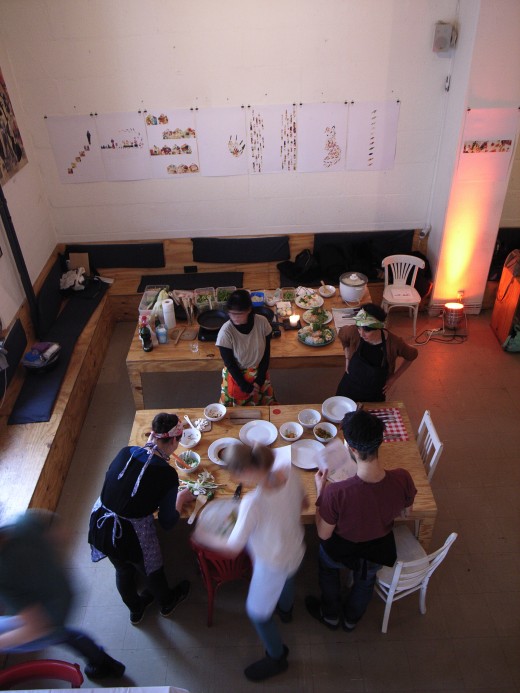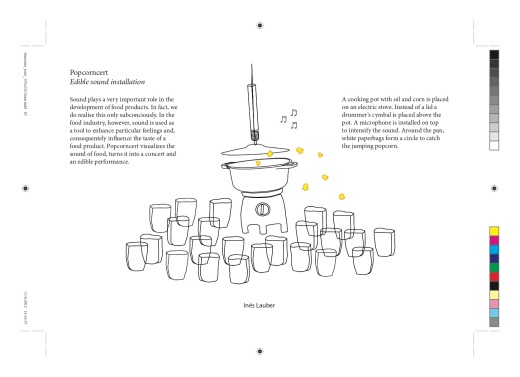thank you dear kavita and maria!
“Der Kiez Eats is a new community of food lovers and chefs in Berlin.
You love to eat. They love to cook.
Whether you’re craving an authentic Indian thali, a stunning Modern Nordic tasting menu, or you just want your wok to finally get some use, find a chef for the occasion in the Kiez.”

Tainá Guedes began her culinary career at a Japanese restaurant in Sao Paulo, and is now a full time chef, artist, and food activist based in Berlin. We asked Tainá to share her thoughts on what it means to be a chef, and tell us about her first book, Kochen mit Brot
1. When you say “I’m a Chef,” what does that mean?
Well, this is a complex question that can be answered in different points of view. For me, to be a chef means that I am nourishing other people with food. Some thoughts about that: maybe the german word for food, “lebensmittel”, which means the “medium of life,” would be a short and good translation for it. The person is not only “giving me” the time they spend eating my food, but also the time they spend working to get the money to pay for it. It is part of her/his life and also, in a way, an “opening [of] a door” to themselves for my food and what my food wants to communicate. What a great gift!
To be chef also means I need to be able to see the qualities of every individual person in my team, make them do the most they can, and motivate them. [It] means I need to be able to manage the business as a whole, considering administration, personnel, and guests.
To be a chef means that people follow what you do, so the chef should also give good examples of relations to nature and men. To quote John Cage, “How to improve the world, without making matters worse.”
2. How did you become a chef? Has the notion of what it means to be a chef changed for you over your career?
I started working in a Japanese restaurant in and out of the kitchen in Sao Paulo, Brazil, in 1997. I created many events relating food and art, food experiments, and in many of them, I had problems with the chef and kitchen staff. I remember when I did a partnership with an olive oil brand: the idea was to create our own flavored olive oil and sell them with recipes. but the chef said that he would not do it, because “in the japanese kitchen we don’t use olive oil.” So, I had to bring another chef to make it, but it was kind of hard for the guest chef to work with his team.
Then, I decided to go to university for gastronomy, and I became an international chef in 2005. After that, I moved to Germany and specialized in vegetarian food. I went to japan to study “shojin ryori,” the ancient Japanese, vegetarian, buddhist food, and traveled to London to learn “raw food” from a New York chef, at the same time that I was developing my own style of cooking.
3. Dave Chang says that as a rule he doesn’t hire anyone who claims to have “great” knife skills. How are your knife skills?
I think I still can improve a lot. I like to imagine the kitchen as training for my soul and for my performance. My father was known to be very precise in his art. I feel I didn’t inherit that quality from him. My feeling is that I can do many things, but none very well. For sure it is important to know what is the best for the vegetables, because the way you cut them has a lot of influence on their taste.
4. If you could cook for anyone in the world, who would it be? What would you cook?
For my father. I would cook all my best recipes, ask about his experiences with macrobiotic foods, and create a culinary journey to his origins, which are basically Arabian, Portuguese, Spanish, Dutch and indigenous.
5. Besides Kitchensurfing, what’s the most exciting thing happening in the Berlin food scene right now?
All the art-food movements. Designers working with food instead of wood, plastic, metal. Artists preparing food in museums, galleries, and ateliers. Nutritionists and cooks making art.
6. What are the influences in your kitchen, and what is “Shojin Ryori”?
The seasons, art, people, biodynamics, anthroposophy, the word “mottainai” (ed. note: a Japanese term meaning “a sense of regret regarding waste”), and shojin ryori.
Shojin Ryori is not just an ancient, beautiful and harmonic, philosophic and devoted ‘ingredient’ of traditional Japanese culture. Much more, it is an expression of a permanent change and renewal. Within modern life’s search for inner balance, health and – all-over –harmonic togetherness and respect, this art becomes more actual and innovative than ever.
Shojin is a Buddhist term that refers to devotion, purification, asceticism or diligence in pursuit of enlightenment and perfection and Shojin Ryori, a type of vegetarian cuisine, was brought into Japan via China and Korea with the introduction of Buddhism in the sixth century.
7. Your first book “Kochen mit Brot” specializes in recipes featuring bread. How did you come to that idea?
I was presenting a project against food waste with my friend Lynn Peemoeller in an action day against waste, “teller statt tonne,” presented by Slow Food, when in the middle of 1,000 people, I met Joachim Weckmann, the owner of the Märkisches Landbrot bakery. He said he liked my work and would like to work with me. I started to think a lot about bread and found out that german people not only eat a lot of bread but also throw a lot of bread away. I brought up the idea of making this book to Joachim, and he was happy to get involved.
8. How is German bread culture different compared to your home country, Brazil?
Well, we can not really compare. We have here a lot of different kind of breads, and years of bread culture. In Brazil, most of the people know just the “pãozinho,” a small, white bread roll. Brazil is a huge country, and Brazilians don’t eat bread with breakfast in the whole country. In the northwest, for example, we get couscous or tapioca pap for breakfast.
9. As you’ve traveled a lot in your life, which country has the best bread?
Germany!
10. Which Berlin bakeries do you like best?
Märkisches Landbrot and Weichardt.
11. What is your favourite kind bread?
I don’t have one favorite. I like the potato and the three-grain from Märkisches Landbrot with the red beet spread — that remembers me on my friend Maite. Their Bärlauch bread, amazing! Oh, and the carrots bread roll! I have to confess that i am very into the breads of Märkisches Landbrot. They have a great selection of bread, and I am lucky to have tasted all of them.
12. What’s the best way to use day-old bread at home?
It depends on the amount of bread you have. I would say: cut into slices and reheat in the oven, or make bread flour, because then you can keep it for longer and and use it in many recipes, from salad to soup or dessert. If there is a lot of bread, re-use part of it, and freeze or give away the other part. You can give your food to neighbors, foodsharing or Berliner Tafel, for example. If you always have stale bread and can’t reuse it, it’s better to consider reducing the amount of bread you buy. Conscious shopping is also a relevant point.
13. What is the best bread for cooking? What kind of bread do you prefer to cook with?
With whole grain bread without seeds or grains on top, you will have more recipe options and the recipes will be healthier. Croutons don’t work well with whole grain, or seeded breads because the seeds and grains burn before the bread. Some desserts also don’t work well with grains because of their texture.
14. Your book includes a few drawings, as well. Are visual arts another pursuit for you?
Thank you very much. I have been doing some work with my paintings and drawings. It was a big surprise for me that people wanted to have them! In the moment, however, I am doing more installations with food than with paintings.
15. I read that you made a food movie. What was it about?
The movie is about a Japanese man who was invited to know hell and heaven. In hell, people were very hungry. They had a lot of food, but the o-hashi (chopsticks) were too long, so they couldn’t bring the food to their mouths. In heaven, they had the same food, the same o-hashi, but they feed each other, so they could eat. It’s a Jewish fairy tale, that i put it into a Japanese context, as the message has no geographic border.
19. Oh, and, what’d you have for breakfast this morning?
Bread with spreads from the market, coffee, fresh orange juice and one fig.
for the german version, recipe and more:
http://kiezeats.kitchensurfing.com/























